湘教版小学英语六年级下期教案
(湘少版)六年级英语下册《unit1 Period 3》教案设计
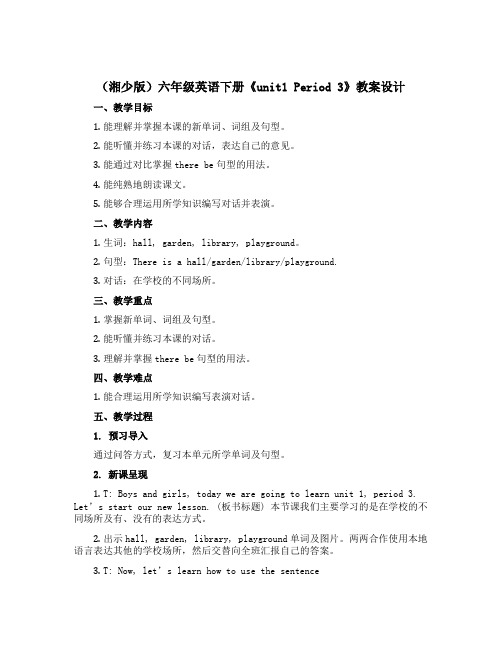
(湘少版)六年级英语下册《unit1 Period 3》教案设计
一、教学目标
1.能理解并掌握本课的新单词、词组及句型。
2.能听懂并练习本课的对话,表达自己的意见。
3.能通过对比掌握there be句型的用法。
4.能纯熟地朗读课文。
5.能够合理运用所学知识编写对话并表演。
二、教学内容
1.生词:hall, garden, library, playground。
2.句型:There is a hall/garden/library/playground.
3.对话:在学校的不同场所。
三、教学重点
1.掌握新单词、词组及句型。
2.能听懂并练习本课的对话。
3.理解并掌握there be句型的用法。
四、教学难点
1.能合理运用所学知识编写表演对话。
五、教学过程
1. 预习导入
通过问答方式,复习本单元所学单词及句型。
2. 新课呈现
1.T: Boys and girls, today we are going to learn unit 1, period 3. Let’s start our new lesson. (板书标题) 本节课我们主要学习的是在学校的不同场所及有、没有的表达方式。
2.出示hall, garden, library, playground单词及图片。
两两合作使用本地语言表达其他的学校场所,然后交替向全班汇报自己的答案。
3.T: Now, let’s learn how to use the sentence。
--湘教版小学六年级英语下册教案(全英版)

湘教版小学六年级英语下册教案Unit 1 You are good at drawing, Peter.Period 1Teaching aims:1.Ss can be confident in English studying.2.Enable the Ss to listen, read, say and write the new words: diving, pictures, good idea, watching films.3.Enable the Ss to be familiar with the sentence pattern: I like doing sth. I’m good at…Teaching emphasis:Enable the Ss to listen, read, say and write the new words.Teaching difficulties:Enable the Ss to be familiar with the sentence pattern: I like doing sth. I’m good at…Teaching tools:Tape, picturesTeaching methods:Task teaching method, Audio-linguistic method.Teaching steps:Step 1 Warming up1.Greetings.2.Make a conversation with the Ss.3.Play a game--- Doing and say.Eg: swimming, running…I like swimming. I’m good at swimming.Step 2 Presentation and drill1. Show the picture of “diving” .T: I like diving. I’m good at diving.The Ss read after the T: Diving, diving, diving.T: Can you spell the word “ diving”, please?T: I like drawing. I’m good at drawing.Show some pictures, and learn the word.2. Learn the other words in the similar way.3. Read together.4. Little teacher.Step 3 Practice1. T: I don’t like running. I like swimming. I’m good at swimming.S1: I don’t like swimming. I like skating. I’m good at skating.…2. The Ss act and say.3. Pair-work.4. Act it out.Step 4 Consolidation1.Evaluation.2.Do Ex.3.Homework. Copy the new words. Design of the blackboard:Unit 1 You are good at drawing, Peter. pictures good idea watch a filmI 'm not good at skating.I’m good at swimming.you are good at drawing, Peter.Unit 1 You are good at drawing, Peter.Period 2Teaching aims:1.Ss can get fun from English studying.2.Enable the Ss to listen, read and say the dialogue.3.Ena ble the Ss to master the sentence pattern: like doing sth, don’t like doing sth. Be good at doing…Teaching emphasis:Enable the Ss to listen, read and say the dialogue.Teaching difficulties:Enable the Ss to master the sentence pattern:like doing sth,don’t like doing sth.Be good at doing…Teaching tools:Tape, pictures, computer.Teaching methods:Task teaching method, Audio-linguistic method.Teaching steps:Step 1 Warming up1.Greetings.2.Act and say.T: I don’t like running. I like swimming. I’m good at swimming.S1: I don’t like swimming. I like skating. I’m good at skating.…Step 2 Presentation and drill1.Ask and answer:T: What do you like doing, Peter?Peter: I like reading. I don’t like singing.2. Listen to the tape and answer the questions.What is Anne like doing?What is Peter like doing?What is Lingling like doing?What is Mingming like doing?3. Explain the difficulties.Step 3 Practice1. Listen to the tape and repeat.2. Read after T.3. Read together.4. Pair-work.5. Little teacher.Step 4 Consolidation1.Evaluation.2.Do Ex.3.Homework.Design of the blackboard:Unit 1 You are good at drawing, Peter.What do you like doing, Peter?I like reading.I don’t like singing.I’m good at swimming.Period 3Teaching aims:1.Enable the to Ss talk about themselves happily.2.Enable the Ss to make sentences about themselves;3. Educate the Ss to finish the Ex.Teaching emphasis:Enable the Ss to talk about themselves.Teaching difficulties:Enable the Ss to finish the Ex.Teaching tools:Tape, computer.Teaching method:Task teaching method, Audio-linguistic method. Teaching steps:Step 1 Warming up1. Greetings.2. Read Part A together.Step 2 Presentation and drill1. T: Now please finish Part D: Talk about ourselves.2. Check the answer.3. Ask two Ss to retell the story.Step 3 Practice1. Class work. Look at the pictures, describe what each person is doing.2. What are they doing? Write sentences about 5 of the above pictures. Write the number of the picture in each box.3. Let’s sing.4. Let’s find out and write. The children are going to the cinema to watcha film. Draw lines to show how they go to the cinema. Write sentences to show how they go there.Step 4 Consolidation1.Do Ex. Workbook Unit 1.2.Evaluation.3.Homework. Revise Unit 1.Design of the blackboard:Unit 1 You are good at drawing, Peter.He is good at running.Jane is good at writing.Sally likes playing football.Period 4Teaching contents :Theme : You’re good at drawing ,Peter.Function: To know the grammar of how to use patterns :1)be good at …, 2) like doing…..Language : What are you good at?I am good at swimming.I am not good at singing.V ocabulary: diving, pictures, skating, good idea, watching films Teaching steps:1.Greetings :a)Good morning/afternoon boys and girls. How are you? Are you happy today ? What’s the weather like today? The Ss greet me at the same time . And answer my questions in correct way.b)Now ,who is on duty today ? The two students will give the class a duty talk that prepared by themselves .2.Warmer:1) Let’s to visit our old friends Lingling, Mingming, Peter and Anne. (CAI SHOWS )2) Review the verbs that we have learnt last term : run, eat, jump, swim, sit, draw, sing, etc.3.Presentation : Activity 1.Part B --let’s learn .1)Play the cassette of the words in Part B . The children listen.2)Play the CAI and ask the Ss to read the words after it several times. Then pause after each word for the Ss , then they read after it.3)Recite: This time ask Ss to recite the words as much as they can . And only give them 2 minutes . Then ask some of them to recite the words and as much as they can. If they also can act the words ,I will give thema praise.4)CAI shows some present participle words ,and ask the pupils to compare them with common verbs .Run Swim Jump sing drawRunning Swimming Jumping singing drawing5)Then lead in the grammar :I like doing sth. out. And give them some examples. Ex: I like swimming.Activity 2.Part A --- Let’s listen and say .Play the cassette and ask the Ss to listen the dialogue twice. Then ask them to answer the questions about the dialogue. It means to understand the dialogue quite well. The questions are:How many persons are there in this dialogue?What was Mingming not good at?Who was good at diving?What did Peter like doing? Etc.Then play the cassette again and ask them to listen once more.3)Explain the sentences if it is necessary .4)Then ask the Ss to read the story several times till fluently .5)Then CAI shows the questions again and ask the Ss to write the answers of questions on the notebook.6)Let the Ss to read their answers and then check the answers together.7)Ask several students to act the story out.Activity 3.Part C ---About the story.1) Ask the pupils to open their books and finish the questions in pairs.4.Homework : 1)Ask them to write 6 times for each word in the exercise book.2)Listen to tape several times at home and finish the exercise of Part F。
湘教版小学六年级英语下册教案(全英版)

湘教版小学六年级英语下册教案Unit 1 You are good at drawing, Peter.Period 1Teaching aims:1.Ss can be confident in English studying.2.Enable the Ss to listen, read, say and write the new words: diving, pictures, good idea, watching films.3.Enable the Ss to be familiar with the sentence pattern: I like doing sth. I’m good at…Teaching emphasis:Enable the Ss to listen, read, say and write the new words.Teaching difficulties:Enable the Ss to be familiar with the sentence pattern: I like doing sth. I’m good at…Teaching tools:Tape, picturesTeaching methods:Task teaching method, Audio-linguistic method.Teaching steps:Step 1 Warming up1.Greetings.2.Make a conversation with the Ss.3.Play a game--- Doing and say.Eg: swimming, running…I like swimming. I’m good at swimming.Step 2 Presentation and drill1. Show the picture of “diving” .T: I like diving. I’m good at diving.The Ss read after the T: Diving, diving, diving.T: Can you spell the word “ diving”, please?T: I like drawing. I’m good at drawing.Show some pictures, and learn the word.2. Learn the other words in the similar way.3. Read together.4. Little teacher.Step 3 Practice1. T: I don’t like running. I like swimming. I’m good at swimming.S1: I don’t like swimming. I like skating. I’m good at skating.…2. The Ss act and say.3. Pair-work.4. Act it out.Step 4 Consolidation1.Evaluation.2.Do Ex.3.Homework. Copy the new words. Design of the blackboard:Unit 1 You are good at drawing, Peter. pictures good idea watch a filmI 'm not good at skating.I’m good at swimming.you are good at drawing, Peter.Unit 1 You are good at drawing, Peter.Period 2Teaching aims:1.Ss can get fun from English studying.2.Enable the Ss to listen, read and say the dialogue.3.Ena ble the Ss to master the sentence pattern: like doing sth, don’t like doing sth. Be good at doing…Teaching emphasis:Enable the Ss to listen, read and say the dialogue.Teaching difficulties:Enable the Ss to master the sentence pattern:like doing sth,don’t like doing sth.Be good at doing…Teaching tools:Tape, pictures, computer.Teaching methods:Task teaching method, Audio-linguistic method.Teaching steps:Step 1 Warming up1.Greetings.2.Act and say.T: I don’t like running. I like swimming. I’m good at swimming.S1: I don’t like swimming. I like skating. I’m good at skating.…Step 2 Presentation and drill1.Ask and answer:T: What do you like doing, Peter?Peter: I like reading. I don’t like singing.2. Listen to the tape and answer the questions.What is Anne like doing?What is Peter like doing?What is Lingling like doing?What is Mingming like doing?3. Explain the difficulties.Step 3 Practice1. Listen to the tape and repeat.2. Read after T.3. Read together.4. Pair-work.5. Little teacher.Step 4 Consolidation1.Evaluation.2.Do Ex.3.Homework.Design of the blackboard:Unit 1 You are good at drawing, Peter.What do you like doing, Peter?I like reading.I don’t like singing.I’m good at swimming.Period 3Teaching aims:1.Enable the to Ss talk about themselves happily.2.Enable the Ss to make sentences about themselves;3. Educate the Ss to finish the Ex.Teaching emphasis:Enable the Ss to talk about themselves.Teaching difficulties:Enable the Ss to finish the Ex.Teaching tools:Tape, computer.Teaching method:Task teaching method, Audio-linguistic method. Teaching steps:Step 1 Warming up1. Greetings.2. Read Part A together.Step 2 Presentation and drill1. T: Now please finish Part D: Talk about ourselves.2. Check the answer.3. Ask two Ss to retell the story.Step 3 Practice1. Class work. Look at the pictures, describe what each person is doing.2. What are they doing? Write sentences about 5 of the above pictures. Write the number of the picture in each box.3. Let’s sing.4. Let’s find out and write. The children are going to the cinema to watcha film. Draw lines to show how they go to the cinema. Write sentences to show how they go there.Step 4 Consolidation1.Do Ex. Workbook Unit 1.2.Evaluation.3.Homework. Revise Unit 1.Design of the blackboard:Unit 1 You are good at drawing, Peter.He is good at running.Jane is good at writing.Sally likes playing football.Period 4Teaching contents :Theme : You’re good at drawing ,Peter.Function: To know the grammar of how to use patterns :1)be good at …, 2) like doing…..Language : What are you good at?I am good at swimming.I am not good at singing.V ocabulary: diving, pictures, skating, good idea, watching films Teaching steps:1.Greetings :a)Good morning/afternoon boys and girls. How are you? Are you happy today ? What’s the weather like today? The Ss greet me at the same time . And answer my questions in correct way.b)Now ,who is on duty today ? The two students will give the class a duty talk that prepared by themselves .2.Warmer:1) Let’s to visit our old friends Lingling, Mingming, Peter and Anne. (CAI SHOWS )2) Review the verbs that we have learnt last term : run, eat, jump, swim, sit, draw, sing, etc.3.Presentation : Activity 1.Part B --let’s learn .1)Play the cassette of the words in Part B . The children listen.2)Play the CAI and ask the Ss to read the words after it several times. Then pause after each word for the Ss , then they read after it.3)Recite: This time ask Ss to recite the words as much as they can . And only give them 2 minutes . Then ask some of them to recite the words and as much as they can. If they also can act the words ,I will give thema praise.4)CAI shows some present participle words ,and ask the pupils to compare them with common verbs .Run Swim Jump sing drawRunning Swimming Jumping singing drawing5)Then lead in the grammar :I like doing sth. out. And give them some examples. Ex: I like swimming.Activity 2.Part A --- Let’s listen and say .Play the cassette and ask the Ss to listen the dialogue twice. Then ask them to answer the questions about the dialogue. It means to understand the dialogue quite well. The questions are:How many persons are there in this dialogue?What was Mingming not good at?Who was good at diving?What did Peter like doing? Etc.Then play the cassette again and ask them to listen once more.3)Explain the sentences if it is necessary .4)Then ask the Ss to read the story several times till fluently .5)Then CAI shows the questions again and ask the Ss to write the answers of questions on the notebook.6)Let the Ss to read their answers and then check the answers together.7)Ask several students to act the story out.Activity 3.Part C ---About the story.1) Ask the pupils to open their books and finish the questions in pairs.4.Homework : 1)Ask them to write 6 times for each word in the exercise book.2)Listen to tape several times at home and finish the exercise of Part F。
新版湘少版六年级英语下册全册教案
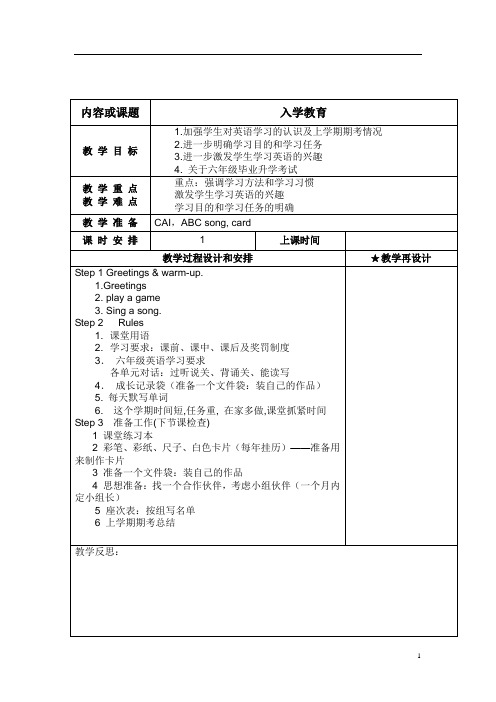
While-reading
(2)First,read it by your yourselves in two minutes. And then do the exercises.
Tick or cross:
Many families go shopping at weekends.( )
(2)运用“直观教学法”教授新单词,让学生学习体验生活中的英语。
教授:outing,movie, together板书学生书空。
2.The dialogue
(1)根据对话回答问题T: Peter and Lingling are talking about their new family outing. Do you want to know what will they do? OK,let’s listen to the tape.(关上书听对话,训练学生的听力。)
2、sing a song :The More We get together
Step 2 Presentation and drill
1 Talk about the pupils in the classroom. Point to a boy and say
He is tall. Point to another boy and say : He is taller.板书taller
教学重点
教学难点
重点:掌握并运用句型“A is /are more…than B”,;理解、阅读本课故事。难点:复述本课故事
教学准备
Word cards, Type,CAI, Drawing Instrument
课时安排
共三课时
新版湘少版六年级英语下册全册教案
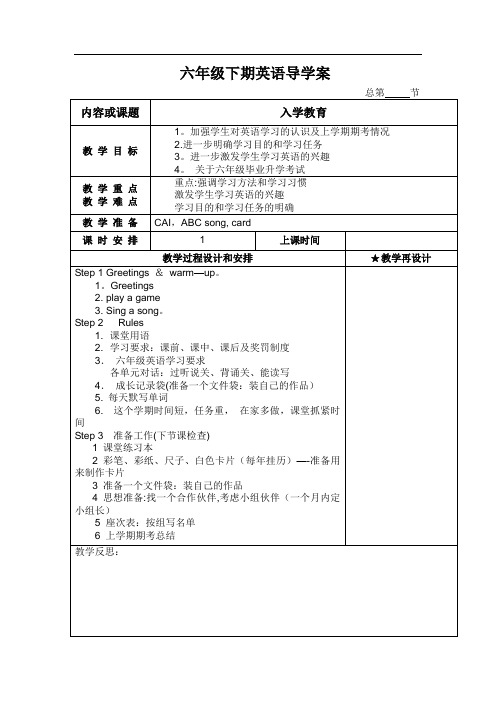
六年级下期英语导学案
六年级下期英语导学案
六年级下期英语导学案
六年级下期英语导学案
六年级下期英语导学案
六年级下期英语导学案
六年级下期英语导学案
六年级下期英语导学案
六年级下期英语导学案
六年级下期英语导学案
六年级下期英语导学案
六年级下期英语导学案
六年级下期英语导学案
六年级下期英语导学案
六年级下期英语导学案
六年级下期英语导学案
六年级下期英语导学案
六年级下期英语导学案
六年级下期英语导学案
六年级下期英语导学案
六年级下期英语导学案
六年级下期英语导学案
总第节
六年级下期英语导学案
六年级下期英语导学案
六年级下期英语导学案
六年级下期英语导学案
六年级下期英语导学案
六年级下期英语导学案。
湘教版小学英语六年级下期教案
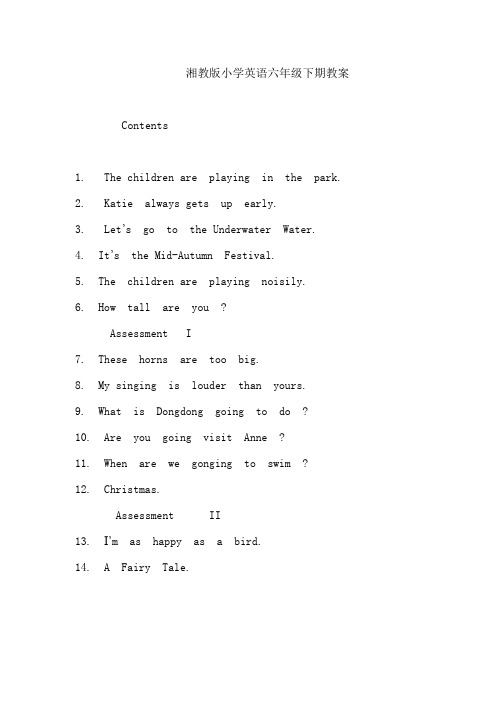
湘教版小学英语六年级下期教案 Contents1. The children are playing in the park.2. Katie always gets up early.3. Let’s go to the Underwater Water.4. It’s the Mid-Autumn Festival.5. The children are playing noisily.6. How tall are you ?Assessment I7. These horns are too big.8. My singing is louder than yours.9. What is Dongdong going to do ?10. Are you going visit Anne ?11. When are we gonging to swim ?12. Christmas.Assessment II13. I’m as happy as a bird.14. A Fairy Tale.1. The children are playing in he park.教学目的:1、学会本单词的新单词:swing, slide, bench bark ,chain bite , stones2、掌握句型:the childer are playing in the park,.3、正确回答本单元的作业中的问题:4.掌握现在进行时的结构,(简单进行见解).动词+ing教学重点:重点: 1、掌握本单元词语。
swing, slide, bench bark , chain bite , stones1、会进行句型练习。
The man is ________The boy is _______-The old is ________难点:情景对话。
教学准备:教学磁带,单词,单词卡片。
教学时间:2课时第一课时教学内容: 第一单元中的A.B 两部分教学过程:一、组织教学:1、师生互相问候:T:HelloS:Hello.2、唱一首英文歌曲:I can sing my ABC二.A部分的教学:# 主句的教学:the childer are playing in the park,.1. 听录音朗读A部分。
湘少版六年级下册英语教案(二)

湘少版六年级下册英语教案(二)湘少版六年级下册英语教案Lesson 1: My Weekend•Objectives:–To introduce and practice weekend activitiesvocabulary–To develop speaking and listening skills–To encourage students to talk about their weekend activities•Warm-up:–Play a short video or show pictures of various weekend activities and ask students to identifythem.–Discuss with students about their favorite weekend activities.•Presentation:–Introduce new vocabulary related to weekendactivities using flashcards or visual aids.–Teach the pronunciation, spelling, and meaning of each word.–Provide examples of sentences using the newvocabulary, and have students repeat after you. •Practice:–Divide students into small groups and give each group a set of picture cards showing differentweekend activities.–Ask students to take turns picking a card and describing the activity to their group members.–Encourage students to ask questions and have discussions about the activities.•Production:–In pairs, have students interview each other about their past weekend activities.–Students should take turns asking and answering questions using the new vocabulary.–Encourage students to provide detailed answers and make conversations more interactive. •Evaluation:–Monitor students’ participation and assess their ability to use the new vocabulary in conversations.–Provide individual feedback and suggestions for improvement.•Extension:–Assign a weekend activity diary as homework, where students need to write about their weekendactivities using the new vocabulary.–Discuss the diary entries in the next class and allow students to share their experiences.Lesson 2: Healthy Habits•Objectives:–To introduce and practice vocabulary related to healthy habits and daily routines–To develop reading and writing skills–To promote awareness of the importance of a healthy lifestyle•Warm-up:–Have a class discussion about healthy habits, such as eating nutritious food, exercising, and gettingenough sleep.–Ask students to share their daily routines and identify which habits are healthy. •Presentation:–Introduce new vocabulary related to healthy habits using flashcards or visual aids.–Teach the pronunciation, spelling, and meaning of each word.–Provide examples of sentences using the newvocabulary, and have students repeat after you. •Practice:–Give students a worksheet with a daily routine schedule that includes gaps for missing words.–Students should fill in the missing words from the vocabulary list to complete the sentences.–Review the answers as a class and discuss the importance of each healthy habit.•Production:–In pairs, have students create a poster orinfographic promoting healthy habits.–Students should include pictures and shortdescriptions of different habits they have learned.–Encourage creativity and effective presentation of information.•Evaluation:–Assess students’ ability to complete the worksheet accurately.–Evaluate the posters or infographics based on their content, visual appeal, and inclusion of keyvocabulary.•Extension:–Organize a class presentation where students can share their posters or infographics.–Discuss as a class the importance of maintaining healthy habits and brainstorm additional ways tolive a healthy lifestyle.Lesson 3: The Weather Report•Objectives:–To introduce and practice vocabulary related to weather–To develop listening and speaking skills–To enable students to describe weather conditions •Warm-up:–Show pictures representing different types of weather and ask students to identify and describethem.–Discuss with students the effect of different weather conditions on their daily lives. •Presentation:–Introduce new vocabulary related to weather using flashcards or visual aids.–Teach the pronunciation, spelling, and meaning of each word.–Use short phrases or sentences to describedifferent weather conditions.•Practice:–Play an audio recording or video of a weather report, focusing on the pronunciation and usage ofweather vocabulary.–Provide students with a worksheet of weatherreports in different cities.–In pairs, students should take turns being the weather reporter and describing the weather in aspecific city.•Production:–In groups, have students create their own weather report scripts.–Each group should include descriptions of weather conditions, temperature, and any special events orprecautions related to the weather.•Evaluation:–Monitor students’ participation and assess their accuracy in describing weather conditions duringthe practice activity.–Assess the scripts created by the groups based on their content, organization, and appropriate use ofvocabulary.•Extension:–Organize a weather report presentation where groups can perform their scripts.–Discuss as a class the different types of weather around the world and their impact on variousregions.以上是针对“湘少版六年级下册英语教案”的几个例子,教案的具体内容可根据实际情况进行调整和扩展。
湘少版六年级英语下册全册教案

湘少版六年级英语下册全册教案一、教学目标本教案旨在帮助六年级学生达到以下英语学习目标:1.熟练掌握动词的过去式形式,并能正确使用它们;2.学会描述过去发生的事情,并能使用过去时态叙述个人经历;3.掌握日常生活中常见的交际用语,并能用英语进行日常交流;4.能够听懂并理解课堂中教师的简单英语指令和问题,并能做出相应反应;5.培养学生们的阅读理解能力,能够读懂课文中的关键信息并回答问题;6.提高学生的口语表达能力,培养他们用英语进行简单的口头表达。
二、教学重点和难点教学重点1.动词过去时的形式和用法;2.过去经历的叙述;3.日常交际用语的运用;4.阅读理解能力的培养。
教学难点1.动词过去时的不规则变化;2.过去时态的正确运用。
三、教学内容与教学步骤Unit 1: My school day1. 教学内容本单元主要围绕描述学生在学校的一天所做的事情展开。
学生将学会使用动词的过去时来描述过去发生的事情,并能使用一般疑问句和回答句进行简单的交流。
2. 教学步骤•Step 1: Pre-reading–创设情境,引入新课,向学生展示与课文相关的图片,激发他们的学习兴趣;–跟学生一起讨论图片内容,引导他们对即将学习的课文内容进行猜测。
•Step 2: While-reading–学生个别展示自己一天的学校生活,并使用过去时句型进行描述;–教师向学生介绍新的词汇和句型,通过示范教学巧妙导入课文让学生更好地理解课文;–学生自主阅读课文,尝试回答课文中的问题,并扩展他们的回答;–小组合作活动:学生分组进行角色扮演,练习使用课文中的句型进行交际。
•Step 3: Post-reading–学生合作讨论并互相校对他们在小组活动中的对话内容;–最后,教师提供反馈和指导,帮助学生纠正错误,并加强对课文内容的理解。
Unit 2: My vacation1. 教学内容本单元主要围绕学生的假期活动展开。
学生将学会使用过去时描述自己在假期里的所见所闻,并能使用简单的句式描述自己的兴趣、喜好等。
新湘教版六年级下册英语教案

Unit 1 A family outing一、学情分析六年级的学生虽然有一定的英语基础,可是在自由表达方面存在困难。
教学设计中应突出教学的多样性和层次性。
二、教学目标1.语言知识目标能听、说、认读本课的重点单词;能正确使用提建议的句型。
2.教学重点:本课句型的运用和单词。
3.教学难点:提建议的句型。
三、教学准备单词卡片和录音机四、教学过程Step 1 Warming upGreetingsStep 2 Presentation1. Learn new wordstogether ride grandparent2. Learn Part AWhere are we going today?Shall we go to the park?(1)Listen to the tape and think(2)Ask some questions and answer(3)Listen and repeat(4)Teach the textStep 3 Practice1.Practise Part B2.Practise Part CStep 4 Consolidation总结本课。
Step 5 Summary评价学生本节课的表现。
Step 6HomeworkUnit 1 A family outing一、教学目标1.语言知识目标能记住本课单词并会默写;能正确使用提建议的句型。
2.教学重点:本课句型的运用和单词。
3.教学难点:句型的运用和语法。
二、教学准备图片、阅读材料和录音机三、教学过程Step 1 Warming up1.Greetings2.ReviewStep 2 Presentation1.Teaching Part DLet’s ReadRead the text and answer the questions.2.Teaching Part ELet’s WriteWrite down your answers.(1) What does your family usually do at weekends?(2) Where does your family usually go at weekends?Step 3 PracticePractise Part FLet’s Have FunLet’s sing a songStep 4Consolidation 总结本节课。
(精华版)湘教版小学六年级下册英语教案

( )4.g d(好)
A.ou B.oo C.ui
( )5.dr (画画) A.aw B.au C.ow
Ⅱ、选择下列英文的汉语意思。
( )6.children A.孩子们 B.一个孩子 C.女孩
( )7.swim
A.游泳 B.滑冰
C.跑步
( )8.film
A.电影院 B.电影
C.电视
( )9.like
教学准备 单词卡片、教学挂图、教学磁带等。
教学程序设计
Step 1 Warming up 1、师生问候。 2、唱已学的英语歌曲。 3、复习有关活动的词汇。 游戏——Guess,guess,guess! (猜一猜) 教师快速做动作(swimming,singing, dancing,writing,reading, piaying football,jumping,flying a kite,skipping,fishing,running, raller-blading,eating,drawing 等),学生迅速地猜出老师的动作。 T:What am I doing? S:You’re swimming/singing/…
教学准备 画有课文 F 部分表格的小黑板或幻灯片、教学磁带等。
教学程序设计
批注
Ⅰ、根据中文提示,选择合适的字母或字母组合,补充单词完整。
( )1.k d(小孩子) A.e B.i C.ie
( )2.pict (图画) A.ure B.aue C.are
( )3.wat (手表) A.th B.ch C.sh
游戏quickresponse快速反应批注让全班学生起立教师快速出示单词卡片或做口型学生快速说出该单词或词组最快说出的学生坐下最后坐下学生最多可让一学生上台充当小老师出示单词卡片或做口型stepfastreadinglistening1出示课文a部分教学挂图让学生们快速阅读课文回答问
新版湘少版小学六年级下册英语全期教案 全册

教学内容或课题
Unit l A family outing P1
教学
目标
1.词汇:能听懂、会说、认读新单词outing,movie,together2.句型:能运用句型询描述家庭郊游“We’ll watch a movie.”3、能够描述家庭成员活动。4、能初步运用B部分词汇。
教学重点
难点
1、重点:能听懂、会说、认读新单词能听懂、会说、认读新单词outing,movie,together。能运用句型询描述家庭郊游“We’ll watch a movie.”
Step 2新课呈现(Presentation)
1.Talk about our family outings during the winter holidays.
(1)带读:Peter’s family, Anne’s family, my family.
(2)T: What is Peter’s family doing? What is Anne’s family doing?
Step 2新课呈现(Presentation)
1.New words ( 1)Listen to the tape of Part B and repeat.
(2)运用“直观教学法”教授新单词,让学生学习体验生活中的英语。
教授:outing,movie, together板书学生书空。
2.The dialogue
教师用课件出示例句描述家庭活动。
While-reading
(2)First,read it by your yourselves in two minutes. And then do the exercises.
Tick or cross:
湘少版小学英语六年级下册精品教案(全册)
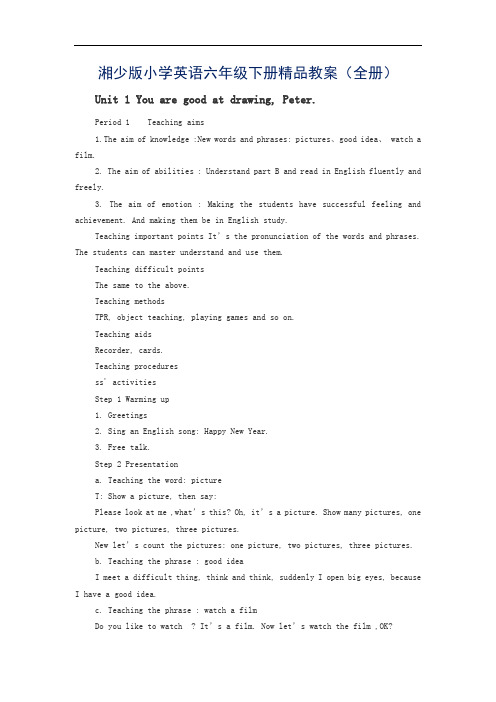
湘少版小学英语六年级下册精品教案(全册)Unit 1 You are good at drawing, Peter.Period 1 Teaching aims1.The aim of knowledge :New words and phrases: pictures、good idea、 watch a film.2. The aim of abilities : Understand part B and read in English fluently and freely.3. The aim of emotion : Making the students have successful feeling and achievement. And making them be in English study.Teaching important points It’s the pronunciation of the words and phrases. The students can master understand and use them.Teaching difficult pointsThe same to the above.Teaching methodsTPR, object teaching, playing games and so on.Teaching aidsRecorder, cards.Teaching proceduresss' activitiesStep 1 Warming up1. Greetings2. Sing an English song: Happy New Year.3. Free talk.Step 2 Presentationa. Teaching the word: pictureT: Show a picture, then say:Please look at me ,what’s this? Oh, it’s a picture. Show many pictures, one picture, two pictures, three pictures.New let’s count the pictures: one picture, two pictures, three pictures.b. Teaching the phrase : good ideaI meet a difficult thing, think and think, suddenly I open big eyes, because I have a good idea.c. Teaching the phrase : watch a filmDo you like to watch ? It’s a film. Now let’s watch the film ,OK?Step 3 Practice.Game 1. Happy passing.The student tells the word to the next one in a soft voice , then oneby one. The last one speak out the word loudly. Who is right,who is the winner.Game 2. Find a friend.Game 3. Quick response.Please look at my hands. And speak out the words and phrases quickly.Step 4 Consolidation.Listen to part B.Step 5 Exercises.Copy the words and phrases:picture, good idea, watch a filmGreetingSingingTalkingLookingGameBlackboard Design:Unit 1 You are good at drawing, Peter.picture---picturesgood ideawatch a filmPostscript:The students can’t go into the status of the new semester at the beginning of term . I must awaken the passion of students to learn English through a variety of ways.Period 2Teaching aims1. The aim of knowledge :Master the drills:be(not) good at + v-ing2. The aim of abilities :Understand and read part A.3. The aim of emotion :Talk about their hobbies.Teaching important points The students can master understand part A and use the sentences: What do you like doing? I’m good at drawing. I’m not good at skating.Be(not) good at+v-ingTeaching difficult pointsThe same to the above and listening.Teaching methodsSimulated -Scene, Hearing methods, Communicative method.Teaching aidsRecorder, cards.Teaching procedures:ss' activitiesStep 1.Warming up.1. Greetings.2. Free talk.Step 2. Review.Going over the learned words and phrases: pictures, good idea, watch a film.Step 3.Presentation and drill.1. Making Simulated –Scene:This is Anne's home. There are some children here. They are talking something. What are they talking about? Please listen.2. Learn some sentences:What do you like doing ?I am good at swimming.I am not good at swimming.Make a example like the above:I’m (not) good at running/skating/drawing/singing…2. For each activity,T helps Ss to make some sentences as the examples.Step 4.Practice .1. Listen to the recorder and read after it three times.2. Read Part A by themselves for five minutes.3. Role play Part A.Step 5.Consolidation.1. Listen and write.2. Homework.GreetingTalking.ListeningActingBlackboard Design:Unit 1 You are good at drawing, Peter.What do you like doing ?I like drawing.I’m good at drawing.I’m not good at skating.[Be(not) good at+v-ing.Postscript:Period 3Teaching aims1. The aim of knowledge : Master the key drills: be(not)good at+ving. Make sentences about yourself.2. The aim of abilities : Listen to the tape, improve the students’ listening.3. The aim of emotion :Talk about their hobbies.Teaching important points The students can master understand the parts:Part C. About the story.Part D .Let’s practice.Part E .Let’s write.Part F .Let’s listen and write.Teaching difficult points The students can use the knowledge.Teaching methods Communicative method.Teaching aids Recorder, cards.Teaching procedures:ss' activitiesStep 1.Warming up.1. Greetings.2. Free talk.3. Role play Part A.Step 2. PresentationⅠ.Answer questions:1.What is Anne good at? She is good at swimming.2. What does Mingming like doing? He likes skating.3. What does Peter like doing? He likes drawing.4. What do all the kids like? They like watching films.Ⅱ.Pairs work:1. What are you good at ?2. What are you not good at ?3. What is your best friend good at ?4. What do you like doing?5. Do you like watching films?Ⅲ.Look at the picture in P3,make a example like the following:e. g. I am good at swimming. I am not good at swimming.1. I am good at jumping.2. I am good at playing table tennis.3. I am good at singing.4. I am good at fishing.5. I am good at drawing.Ⅳ.Listen to the tape carefully and fill in the blank on P4.Step 3.Practice .Step 4.Consolidation.3. Listen and write.4. Homework.Step 5 Sum upGreeting--Talking.----ActingAnsweringAsk and answerBlackboard Design:Unit 1 You are good at drawing, Peter.Be(not) good at+vingPostscript:Unit 2 Anne wanted to skate.Period 1Teaching aims1. The aim of knowledge : Master new words and phrases: skating, rink, learn, fall over, fell over, keep straight, try.2. The aim of abilities : Learn to master these words and expressions.3. The aim of emotion :The students like to study English.Teaching important points The students can use the words and phrases:skating, rink, learn, fall over, fell over, keep straight,Teaching difficult points The same to above.Teaching methods Reading. Logical Memorial Method of English Words.Teaching aids Recorder, cards.Teaching procedures:ss' activitiesStep 1. Warming up1. Greeting.2. Free talk.3. Sing a song: Do Re MeStep 2. Review1. Reading Part A of Unit 1.2. Recite the learned words and expressions.Step 3. Teaching new words.1. Read Part A. Understand it for the first time. Find out new works and phrases.2. Teaching the new words and phrase:a. Skating rinkDrawing a rink. A boy is skating in the skating rink. Tell the students: This is a skating rink.b. LearnLearn from Lei Feng.Live and learn. 活到老,学到老By do we learn. 边做边学c. Teaching the phrase: fall overfall---fellThe teacher acts an old woman, walk slowly, then fall to the ground. I say to myself “I am old , sometimes I fall to the ground.”d. keep straight [streit]Keep your back straight. 挺直你的背Stand up straight.Sit down straight.e. try toPlease try to come. 请你尽可能来。
(湘少版)六年级英语下册《unit 3 period 2》教案设计

(湘少版)六年级英语下册《unit 3 period 2》教案设计一、教学内容本次授课主要内容为六年级英语下册《unit 3 period 2》,教学重点为“Expressing Likes and Dislikes”。
二、教学目标1.让学生能够准确地表达自己的喜好和不喜欢。
2.通过本课学习,提高学生的英语口语表达能力和听力理解能力。
3.培养学生的交际能力,增强他们的自信心。
三、教学步骤1. 预习铺垫1.1. 在上一节课学习的基础上,让学生们复习单词和短语,特别是与喜好和不喜欢有关的词汇。
1.2. 教师用英文向学生展示图片(如快餐、水果、蔬菜、运动器材等),并以问答形式让学生用英语表达自己对这些物品的喜好和不喜欢,为后续课程做好铺垫。
2. 新学知识2.1. 引入新知识:教师用简单易懂的语言,介绍表示喜好和不喜欢的英语句型,例如:•I like hamburgers. (我喜欢汉堡。
)•She doesn’t like vegetables. (她不喜欢蔬菜。
)2.2. 灵活运用:通过询问学生自己的喜好和不喜欢,带领学生灵活运用句型,例如:•Do you like apples? (你喜欢苹果吗?)•Does he like basketball? (他喜欢篮球吗?)•Do they like music? (他们喜欢音乐吗?)2.3. 表达程度:介绍表达程度的词汇,如very、a little、not very等,并让学生练习运用。
3. 练习巩固3.1. 口语练习:让学生以小组为单位,互相询问自己的喜好和不喜欢,例如:“Do you like hamburgers?”、“Yes, I do. How about you?”等等,让他们有机会在课堂上积极参与,提高口语表达能力。
3.2. 听力练习:播放相关语音,让学生听力理解能力得到提高,例如:“I like apples a little.”、“She doesn’t like sports.”等等。
新版湘少版六年级英语下册全册教案

运用查读法进行第二遍仔细阅读,获取信息。然后与同学交流确定答案,自主选择。培养学生的合作学习能力。核对答案。
Post-reading
全班分为两个大组,比赛朗读D部分。这一部分旨在加深对文章的理解,培养学生的英语语感。
Step 3作业布置(Homework)
六年级下期英语导学案
总第节
内容或课题
入学教育
教学目标
1.加强学生对英语学习的认识及上学期期考情况
2.进一步明确学习目的和学习任务
3.进一步激发学生学习英语的兴趣
4.关于六年级毕业升学考试
教学重点
教学难点
重点:强调学习方法和学习习惯
激发学生学习英语的兴趣
学习目的和学习任务的明确
教学准备
CAI,ABC song, card
课时安排
共三课时
上课时间
教学过程设计和安排
★教学再设计
Step 1热身/复习(Warm-up/ Revision)
1.Greetings.
2.Game:Look and say教师利用课件呈现学生熟悉的家庭活动
T:She is beautiful. What is she doing?Ss : She is watching a movie.
(2)运用“直观教学法”教授新单词,让学生学习体验生活中的英语。
教授:outing,movie, together板书学生书空。
2.The dialogue
(1)根据对话回答问题T: Peter and Lingling are talking about their new family outing. Do you want to know what will they do? OK,let’s listen to the tape.(关上书听对话,训练学生的听力。)
新版湘少版六年级英语下册全册教案

写一篇小短文,描述自己家庭成员的活动。
教学反思:
六年级下期英语导学案
总第节
内容或课题
Unit 2 Some stories are more interesting P1
教学目标
1学习本课新单词a piece of, meat ,cross, eat, happily, its, wood, drop, lose, better 2能掌握并用句型“A is /are more…than B”,对两事物进行比较。3能听懂、理解本课故事。4会用like doing more than doing 5通过本课的语言故事,使学生明白做人不要过于贪心的道理。
1.Greetings.
2.Guessing game
收集、挑选3—4张第二课时学生的描述家庭活动的作业,反面朝外贴在黑板上。随即抽取几名学生读出描述活动并找到错误处,这一环节旨在体会玩中学,学中玩,提高英语学习的兴趣,为学生口头作文打下基础。
Step 2新课呈现(Presentation)
1.话题导入。
六年级下期英语导学案
总第节
内容或课题
入学教育
教学目标
1.加强学生对英语学习的认识及上学期期考情况
2.进一步明确学习目的和学习任务
3.进一步激发学生学习英语的兴趣
4.关于六年级毕业升学考试
教学重点
教学难点
重点:强调学习方法和学习习惯
激发学生学习英语的兴趣
学习目的和学习任务的明确
教学准备
CAI,ABC song, card
教师用课件出示例句描述家庭活动。
While-reading
(2)First,read it by your yourselves in two minutes. And then do the exercises.
- 1、下载文档前请自行甄别文档内容的完整性,平台不提供额外的编辑、内容补充、找答案等附加服务。
- 2、"仅部分预览"的文档,不可在线预览部分如存在完整性等问题,可反馈申请退款(可完整预览的文档不适用该条件!)。
- 3、如文档侵犯您的权益,请联系客服反馈,我们会尽快为您处理(人工客服工作时间:9:00-18:30)。
湘教版小学英语六年级下期教案 Contents
1. The children are playing in the park.
2. Katie always gets up early.
3. Let’s go to the Underwater Water.
4. It’s the Mid-Autumn Festival.
5. The children are playing noisily.
6. How tall are you ?
Assessment I
7. These horns are too big.
8. My singing is louder than yours.
9. What is Dongdong going to do ?
10. Are you going visit Anne ?
11. When are we gonging to swim ?
12. Christmas.
Assessment II
13. I’m as happy as a bird.
14. A Fairy Tale.
1. The children are playing in he park.
教学目的:
1、学会本单词的新单词:swing, slide, bench bark ,
chain bite , stones
2、掌握句型:the childer are playing in the park,.
3、正确回答本单元的作业中的问题:
4.掌握现在进行时的结构,(简单进行见解).动词+ing
教学重点:
重点: 1、掌握本单元词语。
swing, slide, bench bark , chain bite , stones
1、会进行句型练习。
The man is ________
The boy is _______-
The old is ________
难点:情景对话。
教学准备:教学磁带,单词,单词卡片。
教学时间:2课时
第一课时
教学内容: 第一单元中的A.B 两部分
教学过程:
一、组织教学:
1、师生互相问候:
T:Hello
S:Hello.
2、唱一首英文歌曲:I can sing my ABC
二.A部分的教学:
# 主句的教学:the childer are playing in the park,.
1. 听录音朗读A部分。
2、句型The man is ________
The boy is _______-
The old is ________
3、指导学生朗读A部分的句子。
三、B部分的教学。
这部分要求学生学习单词
1、出示单词卡片。
swing, slide, bench bark , chain bite , stones
四、指导学生书写句子,单词
第二课时
教学内容:C~F部分
一、组织教学:
教学过程:
1、师生互相问候:
T:Hello ,boys and girls, I’ m miss He. How are you ?
S:Hello….
2、唱一首英文歌曲: Sing a song , How are you?
二、复习
1、复习A部分的内容。
指导学生朗读A部分的内容,注意要认真
2、出示单词卡片,开火车认读
三、C部分的教学。
1. 指导学生弄懂C部分的作业含义,
2. 正确排列序号. 5, 1 3 2 6 4
四、D部分的教学:这部分主要根据图片回答问题查中回答,
He is ___________________________________________
The man is ___________________________________.
The man is ___________________________________.
The boy is ____________________________________.
The boy is ____________________________________.
The old man is ________________________________,
She is ___________________________________________ The girl is _________________________________. 五、E部分的教学,指导学生学会这首英语歌曲:
Longdon Bridge,
六、F部分的教学:Let’s find out and write
指导学生看图,通过看图,找出迷宫中的答案.
1. Peter is going to the cinema by ____________.
2. Anne is ___________________________________’
3. Lingling is __________________________________’.
4. Mingming is __________________________________.。
